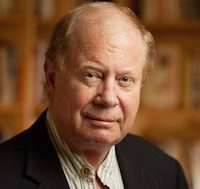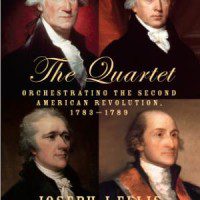The political protest movement known as the Tea Party takes its name, some of its protesters’ costume choices, and ostensibly its inspiration from American Revolutionary history. So historians specializing in this era have stepped in to evaluate the movement’s claims of faithfulness to the views of the founding fathers. An exemplar is Jill Lepore’s The Whites of Their Eyes: The Tea Party’s Revolution and the Battle Over American History. See also Gordon Wood’s surprising critique of that book, as well as Ron Chernow’s measured take.
In 2013, acclaimed historian Joseph J. Ellis joined the fray with an op-ed in the LA Times which argued that despite the Tea Party’s claims that they revere the Constitution, they in fact appear to want their country to be guided by the principles of the very document the Constitution was created to replace: the Articles of Confederation. He writes that the Tea Party’s “ultimate destination, I believe, is the 1780s and our dysfunctional government under the Articles of Confederation. The states were sovereign in that post-revolutionary arrangement, and the federal government was virtually powerless.” According to Ellis, we can better make sense of the Tea Party’s commitments if we recognize that their historical nostalgia is actually for a pre-Constitutional time. As he puts it, “It makes comprehensible their deep disregard for the destructive consequences of their anti-government policies, for they truly believe that government is ‘them,’ not ‘us.’”
While the mass protests have subsided, questions about the meanings and implications the Tea Party remain pressingly relevant, with, for example, a block of representatives in Congress self-identifying as Tea Party members. Ellis’s new book, The Quartet: Orchestrating The Second American Revolution, 1783-1789, offers some answers. It focuses is on exactly the moment when the country’s founders led the effort to replace the Articles of Confederation with a Constitution that would establish a federal government. Ellis has written eight books on early American history, including the Pulitzer Prize-winning Founding Brothers. But his career is also marred by a bizarre record of Brian-Williams-like falsehoods about his personal experiences.
With The Quartet, Ellis provides a swift and thoughtful account of the extreme uphill battle to create the American Constitution. From our point of view, it may seem obvious that the American Revolution would not only liberate the colonies from British rule, but also lead to them to establish a federal union, rather than remain thirteen distinct and only loosely associated entities. History shows this to have been anything but inevitable. Ellis writes, “the dominant historical forces of the 1780s were centrifugal rather than centripetal, meaning that the vast majority of the citizens had no interest in American nationhood; indeed, they regarded the very idea of a national government as irrelevant to their local lives and ominously reminiscent of the British leviathan they had recently vanquished”. The book deftly captures the power plays, the stakes, the biting frustrations, and the rushing excitement that accompanied the push for nationhood. Ellis follows four figures, the title’s quartet—George Washington, James Madison, Alexander Hamilton, and John Jay, their portraits arranged in the four quadrants of the jacket cover like the Let It Be album, or, if you prefer, Dynasty. Through the clever machinations of these four founders, a convention was assembled; a document was hammered out through contentious debate; it was ratified through individual state conventions; and then it was amended with the Bill of Rights. Their success in creating a federal system that unified the colonies was such a momentous feat that Ellis urges us to consider it a second American Revolution.

Ellis defines this crucial moment in American history as a clash between those who preferred the status quo of a limply confederated collection of states, and those who favored constructing a unified nation. Against a progressive Beardian school of thought (which, as Ellis sees it, mistakenly reduces the motivations of the founders to bald economic pursuits), The Quartet casts the creation of the Constitution as a high-stakes political gambit. He writes, “The great conflict, as I see it, was not between ‘aristocracy’ and ‘democracy,’ whatever those elusive categories might mean, but rather between ‘nationalists’ and ‘confederationists,’ which is shorthand for those who believed that the principles of the American Revolution could flourish in a much larger political theater and those who did not”. Ellis can’t emphasize enough just how strongly the general population was against the idea of a strong central government. For most Americans in the decade following the war, any sort of federal power would have been regarded as suspiciously similar to the British rule they had just fought to overturn. Under the Articles of Confederation, a strong federal government wasn’t simply left half-done; it was purposefully curbed. Hauntingly, this general antifederal conviction helps to explain the disgraceful conditions that Washington’s soldiers suffered during the war. As Ellis explains, “the unspoken and unattractive truth was that the marginal status of the Continental Army was reassuring to the vast majority of Americans, since a robust and professional army on the British model contradicted the very values it was supposedly fighting for. It had to be just strong enough to win the war, or perhaps more accurately not to lose it, but not so strong as to threaten the republican goals the war was ultimately about”.
It was through their experiences in the Revolutionary War that Washington and Hamilton became ardent nationalists. The continuous lack of basic provisions for his troops put Washington in a position of constant pleading, both to the enfeebled Congress, and to the individual states. Jay’s drive for a strong federal government stemmed from his frustrations as an ambassador, representing not a distinct nation, but an awkward conglomeration of sovereignties, some of which were sending their own competing emissaries. Just before the end of the war, Hamilton wrote that Americans’ fear of centralized national power would leave us with “a number of petty states with the appearance only of a union, jarring, jealous and perverse, without any determined direction”. As Jay wrote to John Adams, “Our federal government is incompetent to its objects, and so as it is in the Interest of our Country, so it is the Duty of our leading Characters to Cooperate in measures for enlarging and navigating it”. But even next to the fiery commitments of Jay and Hamilton, Washington emerges as the most startlingly forceful and consistent on the matter: “We are either a United people or we are not… If the former, let us, in all matters of general concern act as a nation… If we are not, let us no longer act a farce by pretending to it”. It was Washington’s decision to wager his immense prestige on participation in the Constitutional Convention (shrewdly convened for maximum patriotic impact in the same room in Philadelphia where the Declaration of Independence was signed) that granted the assembly its legitimacy.
The best chapter belongs to Madison and his fight at the Convention for a muscular central government. Ellis goes through the details of Madison’s argumentation, including his crucial dismantling of the widely held notion, inherited from Montesquieu, that republican government can only function within small-scale countries. In Ellis’s account, the efforts of Madison, Washington, Hamilton and the other players at the convention (including Benjamin Franklin and Robert Morris) amounted to “a second founding in which the ‘spirit of ’87’ replaced the ‘spirit of ’76,’ establishing and institutionalizing a national political framework capable of functioning on a much larger scale, yet doing so without threatening the hard-won liberties of the first founding”. And in a reversal of his op-ed summary of the Tea Party above, he notes that in the eyes of these founders, “The federal government must become ‘us’ rather than ‘them’”.
One thing that made me a bit uncomfortable with the perspective of this book is just how much credit Ellis insists we attribute to his quartet. This is certainly a “great man” account of American history. Ellis does not merely claim that the actions of these figures were important, or that a focus on their lives provides a useful window into these times. He doubles down: “My argument is that four men made this transition from confederation happen… If I am right, this was arguably the most creative and consequential act of political leadership in American history”. This perspective results in a number of problems. While the actions of these four figures are shown to be crucial and consequential, larger details of the world of America in the 1780s remain obscure. The book’s exclusive focus on a particular segment of the political elite makes it difficult to understand how the events of the decade shaped—and were shaped by—those who didn’t belong to this particular political class. Those outside of Ellis’s quartet and their inner circle of accomplices are cast broadly as rather politically myopic. But this seems strange for a population that has just staged a successful revolution. And if the general populace was on such a different page from this selection of founders, then it’s hard to see why the Constitution ended up getting ratified successfully, state by state, sometimes unanimously and sometimes by only a thin margin.
Ellis mentions the Tea Party in The Quartet only twice—though the book is otherwise devoid of commentary on current events. Toward the end of the volume Ellis covers the contentious disputes over ratification, with a focus on the debates between Madison and Patrick Henry. Henry argued vehemently against the ratification of the Constitution, casting the proposed federal government as an enormous and tyrannical monster. In parentheses, Ellis adds that, “Modern-day Tea Partiers share this political legacy, with its deep roots in the hostility to any robust expression of government power at the federal level”. He reiterates this point in a footnote reviewing the history of antifederalist sentiments in the US, from the efforts to thwart ratification through the Confederacy of the Civil War: “The Tea Party movement that emerged in the twenty-first century is a modern-day echo of the Antifederalist mentality”.
Insofar as today’s Tea Party is against a robust and active federal government, this book shows their aims to be at odds with those of America’s central founding fathers.




